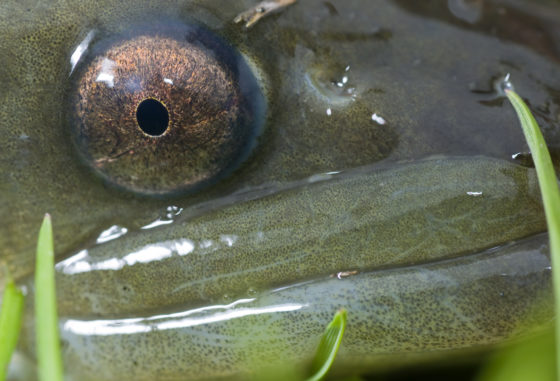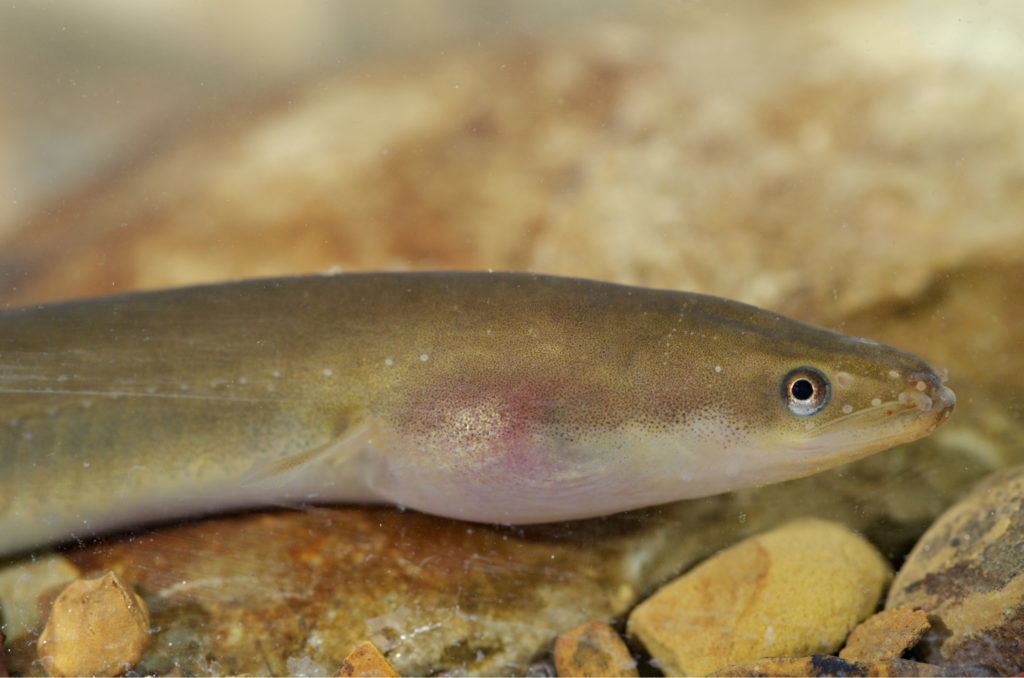European eel
The European eel has one of the greatest geographical ranges of any fish stock in Europe. It moves between habitats as diverse as the open ocean and high seas, sheltered coasts, large lakes and small ponds, wetlands, big rivers and the smallest streams.
The European eel (Anguilla anguilla) population has declined dramatically since the 1970s . Eels used to make up more than 50 percent of the fish biomass in some freshwater systems in Europe – we are a very long way from that today. With millions of glass eels still arriving at the European coastline, it is perhaps hard to imagine that it is threatened. However its distribution has shrunk and the recruitment is down to somewhere around 0.5–10 % of earlier levels (ICES, 2022).
Complex life cycle
The European eel is an extraordinary fish with a complex life cycle. Eels are born in the Sargasso Sea. After spawning, the eel larvae (leptocephali) drift with the Gulf Stream and North Atlantic Drift to the coastal waters of Europe and Northern Africa. Once there, they transform into glass eels and either stay in coastal waters or migrate into freshwater habitats, changing again into yellow eels.
Roughly 10–20 years later, eels reach their final stage as silver eels and travel thousands of kilometres back to the Sargasso Sea, where they spawn once and then die. There are still many unknowns regarding the spawning of European eel. A study published in 2022 was the first to provide direct evidence of the European eel spawning migration to the Sargasso Sea (Wright et al, 2022), but the process remains mysterious.

Why are the eels threatened?
In less than 50 years, the European eel has gone from one of Europe’s largest, most widespread fish populations to a critically endangered species. The following factors are all believed to have had a negative impact:
- Loss of and damage to freshwater habitats
- Migration barriers (including damming for hydro-electric power)
- Pollution
- Diseases and parasites
- Overfishing
- Illegal fishing and trade
- Changes in the marine environment
- Climate change
Management and fishing limits
Despite its critical status, fishing for European eel is widespread across the EU and beyond. It is also the focus of a lucrative illegal fishing and trade, meeting demands from markets in East Asia. Only Ireland, Slovenia, Norway and some regions in Italy and Spain have completely prohibited eel fishing.
The European Union agreed on a joint management framework already in 2007 (Regulation (EC) 1100/2007), with objectives and measures to be implemented by the Member States. In 2018, the General Fisheries Commission for the Mediterranean (GFCM) agreed on a multiannual management plan for eel in the Mediterranean Sea. In addition, an international management framework has been discussed under the Convention for Migratory Species (CMS).
The status of the European eel population is assessed every year by the Joint EIFAAC/ICES/GFCM Working Group on Eels and advice on fishing opportunities and, recently, conservation is provided by ICES. In 2021, the longstanding advice of “all anthropogenic impacts as close to zero as possible” changed to zero catch of all life stages in all habitats, including glass eels for restocking and aquaculture. In 2022, this was further strengthened by conservation advice that all other anthropogenic mortalities should also be zero and the quantity and quality of eel habitats should be restored.
In response to the ICES advice, the EU has also adopted a temporal closure of all eel fishing in EU waters aimed at protecting the spawning migration. A similar closure is included in the GFCM measures but applies to all waters. For 2023, the previous 3 month closure was extended to 6 months.
Moving forward
Further actions to secure eel recovery are urgently needed. FishSec is working together with a wide network of partners, under the banner of European Eel Alliance, across the eel’s geographical range, in order to make this happen.
Our focus is:
- The creation of an international instrument for the protection and recovery of European eel – the Action Plan being developed under the Convention for Migratory Species (CMS).
- A better EU management framework and improved implementation in line with the overarching objectives of both the Common Fisheries Policy and for biodiversity.
- Increased regional coordination of actions for eel recovery, particularly in the Baltic Sea region (HELCOM and BALTFISH) and the Mediterranean region (GFCM).
- An improved control and trade regime for European eel.
 You can find recordings of our eel webinars on YouTube:
You can find recordings of our eel webinars on YouTube:
Webinar: Restocking of European Eel 26 April 2022
Webinar: Save our Eel Webinar – Good Fish Foundation and FishSec 2021
Last updated: October 13, 2023
